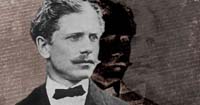
Bierce, Ambrose Gwinnet was an American writer of satire. He was born on June 24, 1842, in Horse Cave, Ohio, into a family of devout Connecticut farmers. He was the tenth of thirteen children in the family. He received no systematic education.
Ambrose Bierce’s career began with journalism. He devoted thirty-seven years, from 1872 to 1909, to this challenging endeavor. Bierce was equally satirical and cynical in his ability to tell the world about cultural and social breakthroughs as well as financial meltdowns and murders.
Ambrose Bierce had the reputation of being the most influential journalist in the United States, and his "horror" stories were placed on a par with those of the horror masters Edgar Allan Poe and Howard Phillips Lovecraft. In his dark, pessimistic ones, he explored the darker sides of the human character. Many of his works feature themes of death and the meaninglessness of human existence.
In 1866 he settled in San Francisco. Soon he decided to become a writer, met B. Garth, C. Stoddard, and other writers. On December 25, 1871, Beers married Mary Ellen Day, and in 1872 the newlyweds went to London on a honeymoon. Bierce remained there until 1877. At that time London society was experiencing a fascination with writers of the American West, and "Bitter Beers," as he was nicknamed, gained a certain fame. Three collections of his stories were published in London: (Nuggets and Dust Panned out in Califirnia, 1872), The Fiend's Delight, 1872, and Cobwebs from an Empty Skull, 1874. In 1877 Bierce returned to San Francisco, where he began a collaboration with Overland Monthly published in part The Devil's Dictionary. ). His first book, Tales of Soldiers and Civilians, later entitled In the Midst of Life, was enthusiastically received by critics. Bierce was hailed as a master of caustic humor, unexpected denouements, and contrasts of the terrible and the beautiful. Then came "Black Beetles in Amber" (1892), "Can Such Things Be?"(1893), "Fantastic Fables" (1899).
In October 1913, Ambrose Bierce, at the age of 71, took a tour of the Civil War fields. He is said to have traveled with Pancho Villa's army.
The last mention of Bierce is dated December 26, 1913. At that time he wrote a letter to a friend: "As for me, I am leaving tomorrow for an unknown destination." The letter has not survived in the world's photographic archives, which casts doubt on the very fact of its existence. Nevertheless, the writer has been missing ever since.
Polnikov Alexey , librarian of the Department of the International Book

